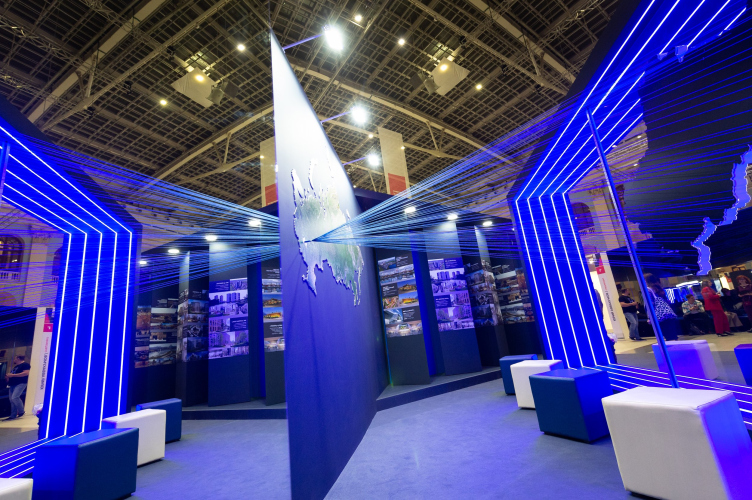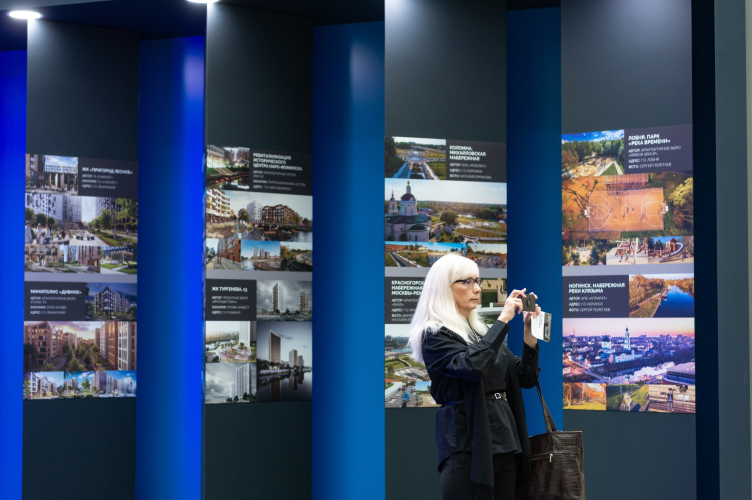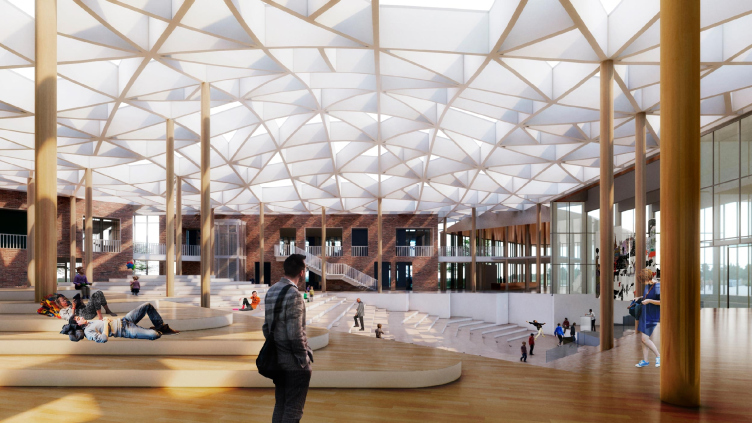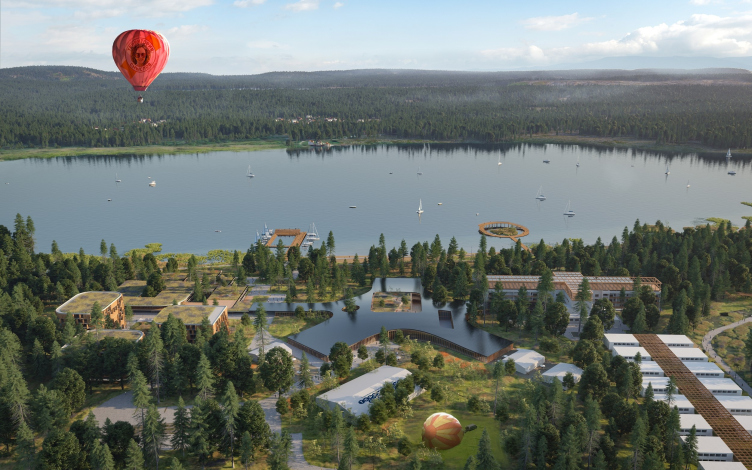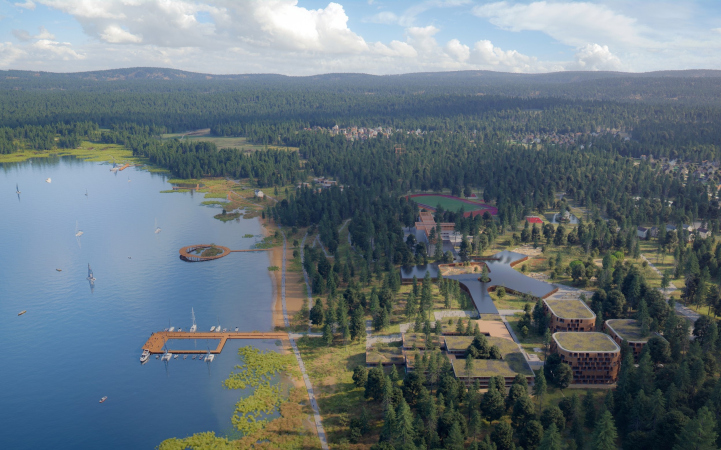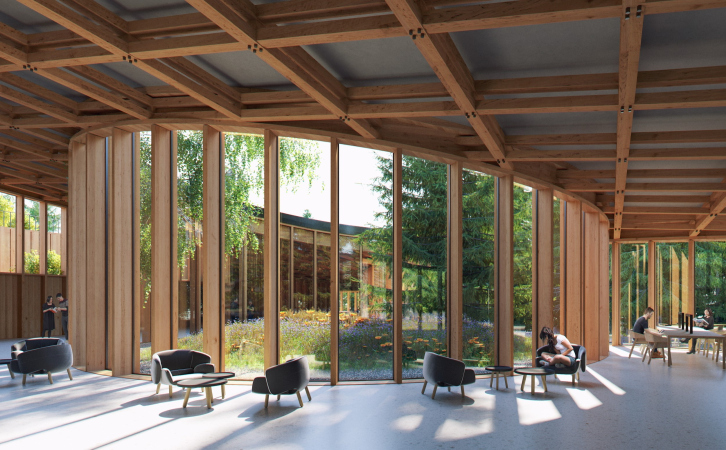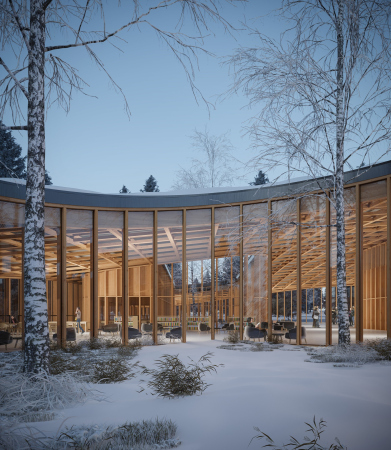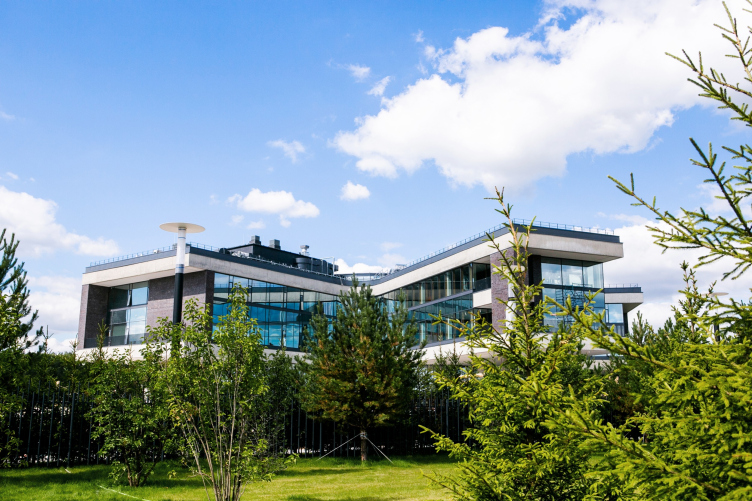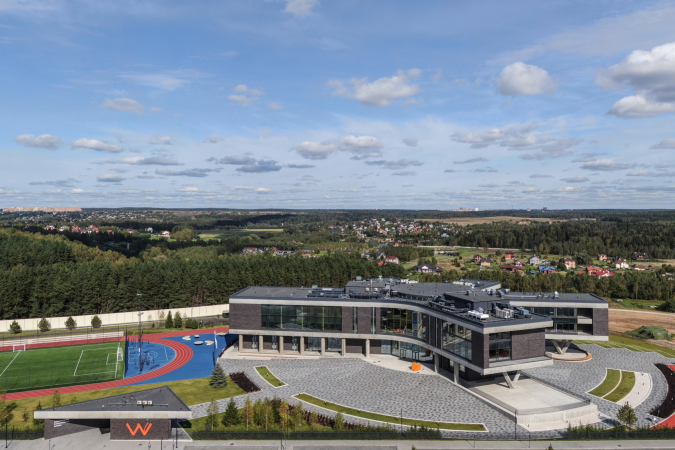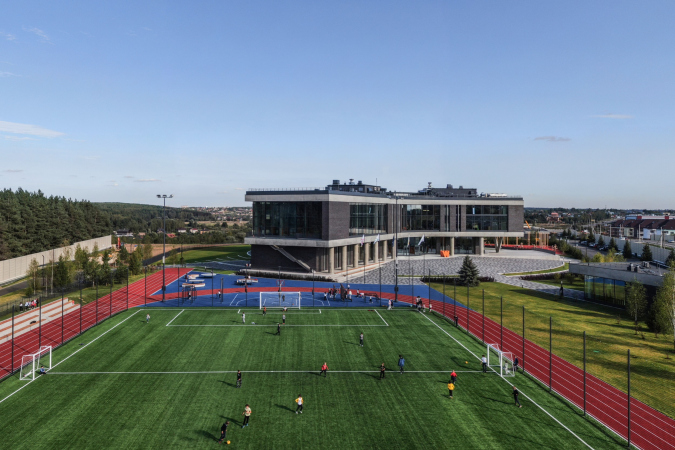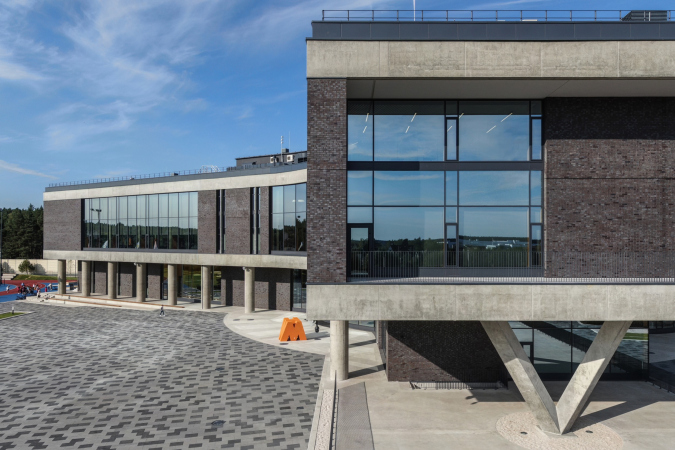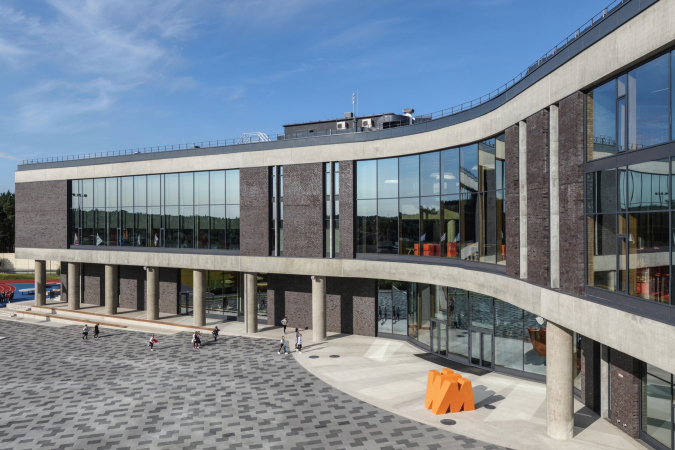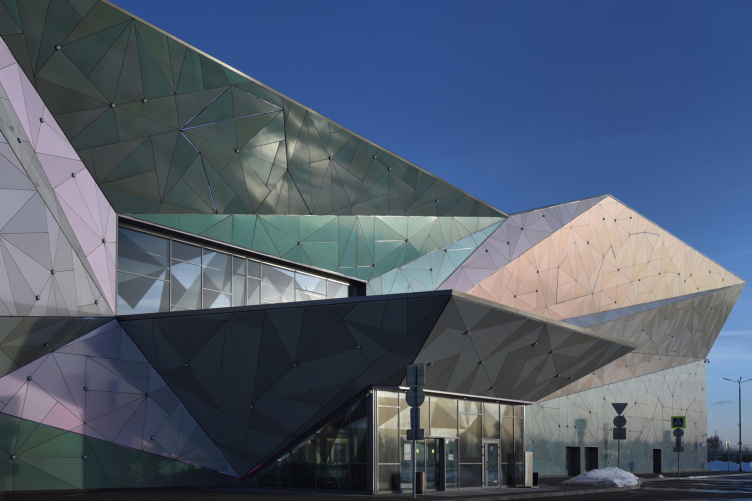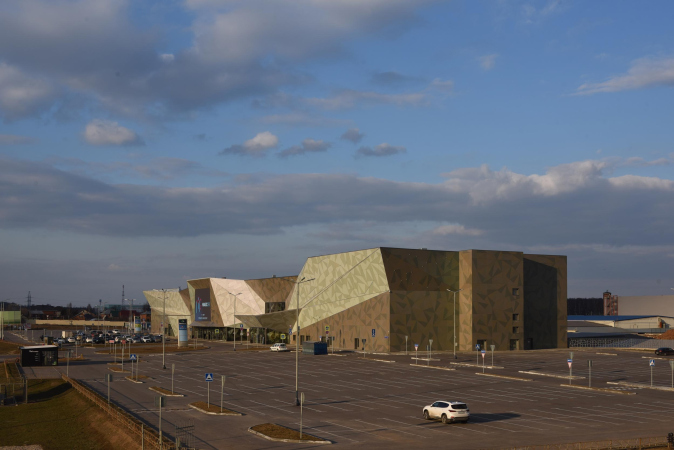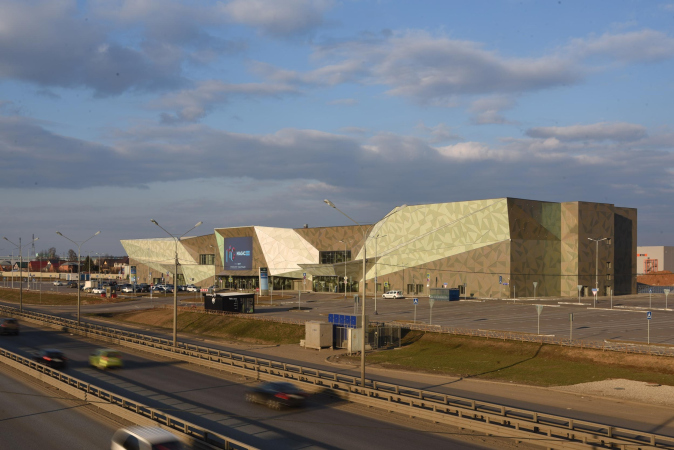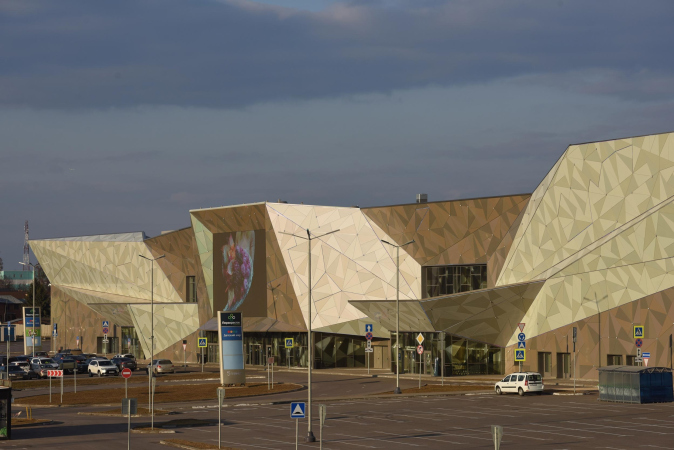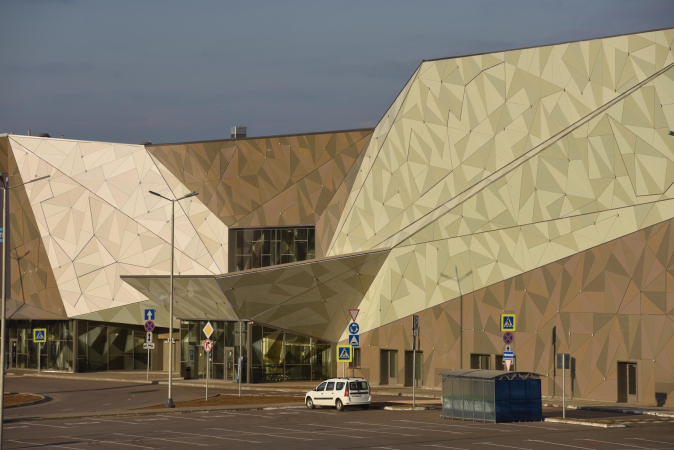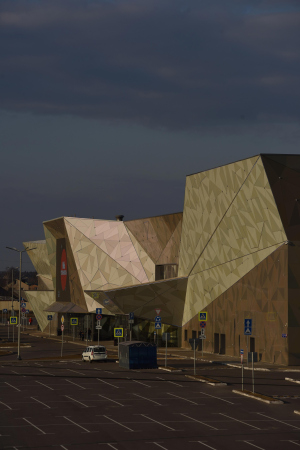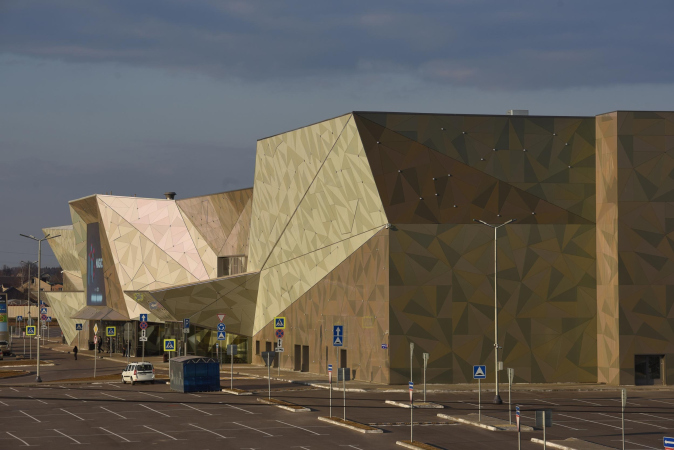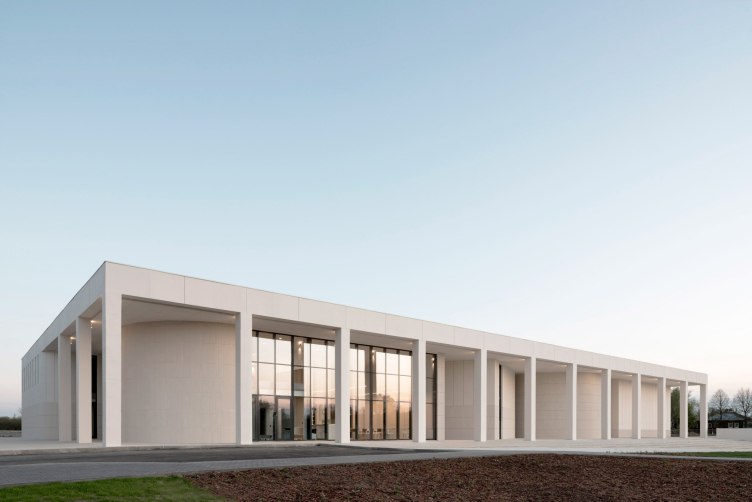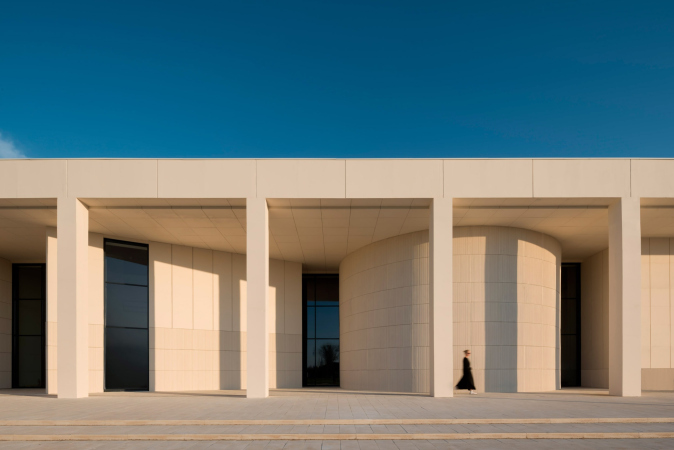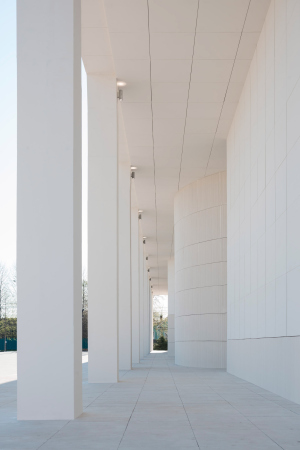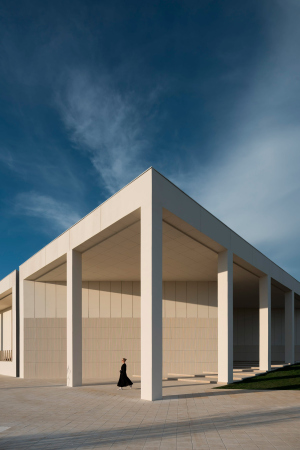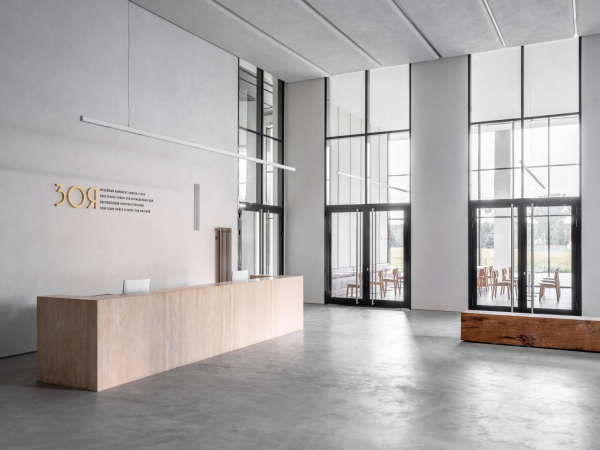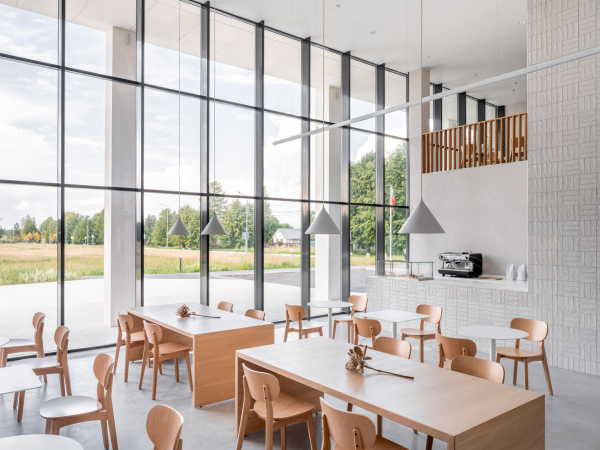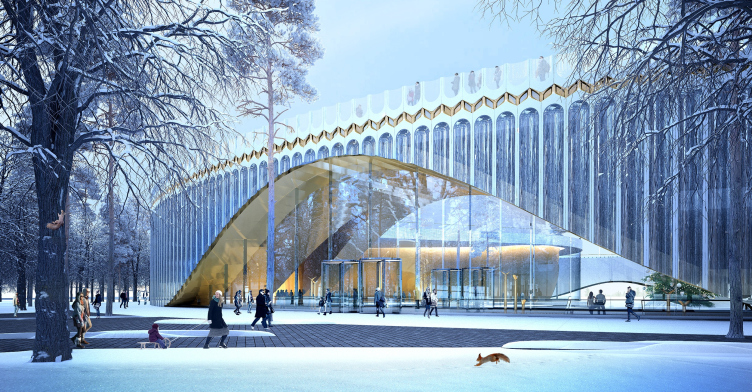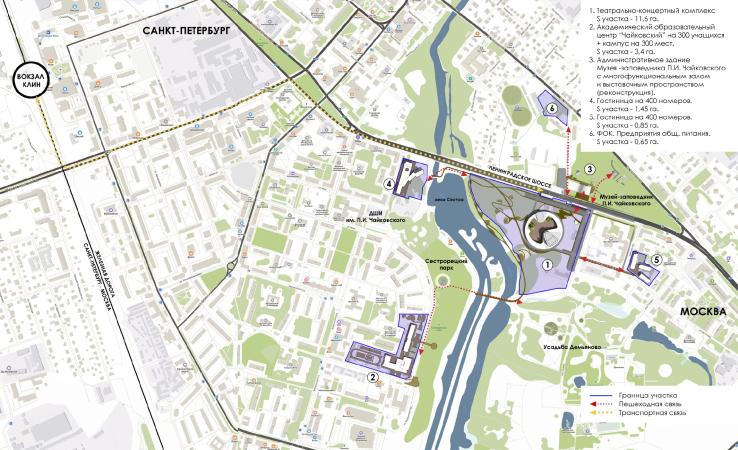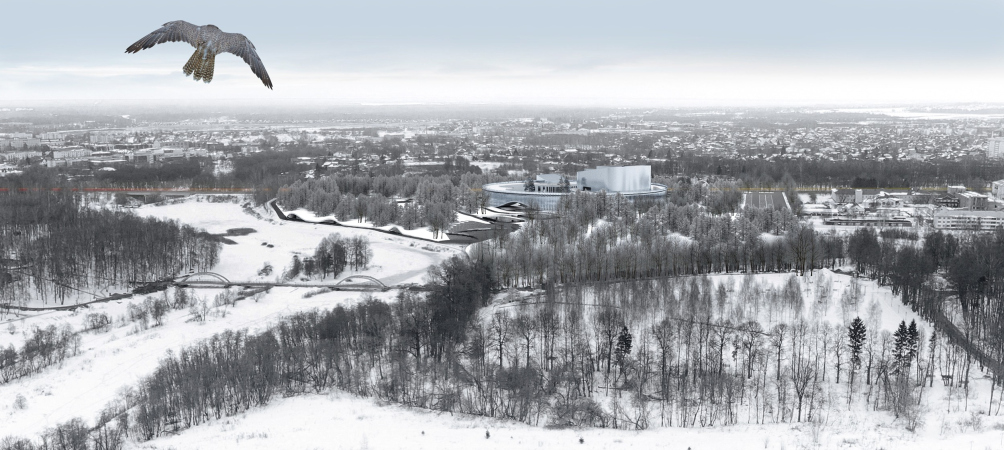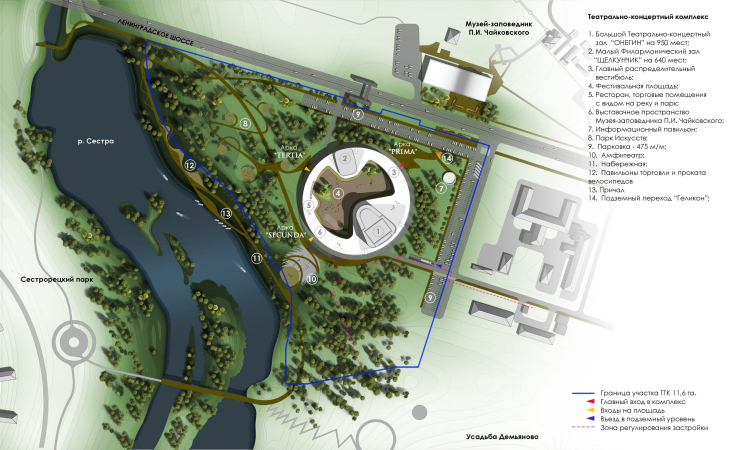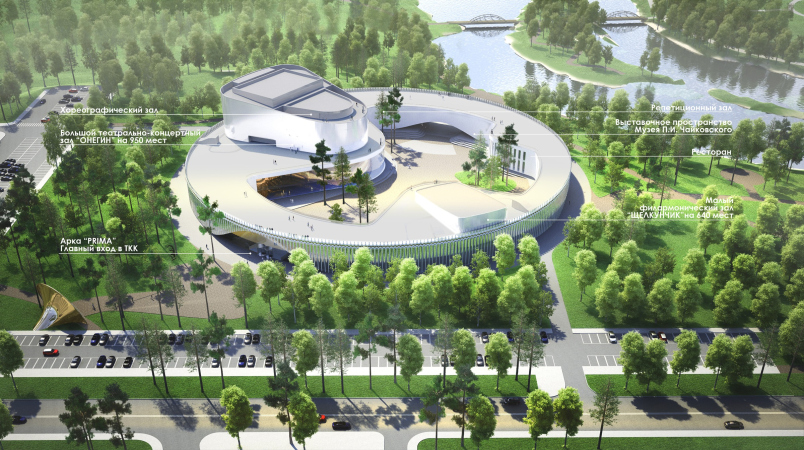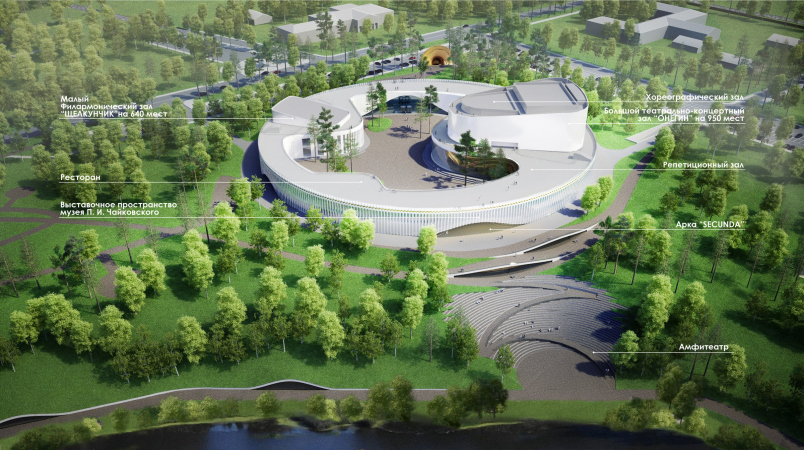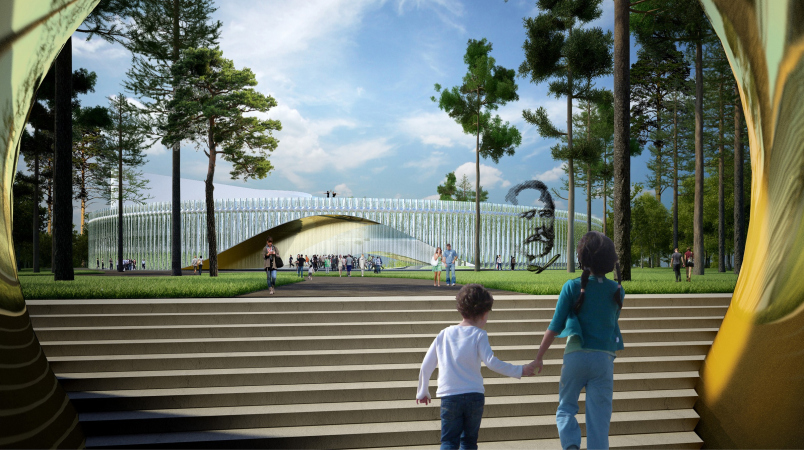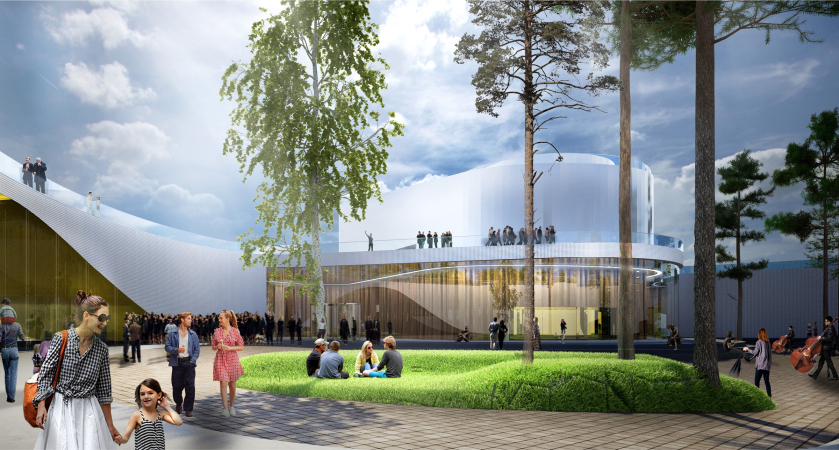The Mosoblarkhitektura booth at Zodchestvo festival
Copyright: Photograph: provided by Mosoblarkhitektura
The Mosoblarkhitektura booth at Zodchestvo festival
Copyright: Photograph: provided by Mosoblarkhitektura
This year, the Moscow region’s booth was dominated not by the strings pulled through its map, not by a glowing frame, and not even by the lowercase “o” that you could sit upon – but by prismatic displays that demonstrated 42 projects in a mirror setting. The judging panel awarded the Moscow Region the “gold” diploma, and this became for us a suitable occasion for reviewing projects built or currently in construction. We decided to start with the brightest ones – some of them are really spot-on now, some not so much, and some did not get enough press coverage. However, all the projects can be considered to be “star” ones – or at least attention-worthy.
E.M. Primakov Gymnasium, 2nd stage. The lobby
Copyright: © Studio 44
Primakov Gymnasium, Stage 2
Architect
Studio
Where
Russia, Odintsovo
Date
2019 — /
Function
Education / School
Stage 2 of the Gymnasium was designed by Studio 44 – the architects of several very high-profile buildings with an educational function, and, as a consequence, the experts in this field. We have already covered this project.
In the gymnasium, instruction is given in two languages, Russian and English, and new teaching methods are developed. The building is quite a match for that: thematic blocks are accommodated in designated volumes, grouped together around a spacious atrium/amphitheater, some of the buildings being more open and some less open to this space that can serve as a place for the students communication, or, if needed, be turned into an event hall.
The complex is being built not far away from Moscow, next to the famous settlement of Razdory, and the architects are interpreting their project as a “transition” one in terms of the scale: it stands between private residences on the one side and the building of the first stage of the gymnasium on the other. The design process was far from simple: as it turned out, the land site had an incredible number of restrictions and underground communications.
In the gymnasium, instruction is given in two languages, Russian and English, and new teaching methods are developed. The building is quite a match for that: thematic blocks are accommodated in designated volumes, grouped together around a spacious atrium/amphitheater, some of the buildings being more open and some less open to this space that can serve as a place for the students communication, or, if needed, be turned into an event hall.
The complex is being built not far away from Moscow, next to the famous settlement of Razdory, and the architects are interpreting their project as a “transition” one in terms of the scale: it stands between private residences on the one side and the building of the first stage of the gymnasium on the other. The design process was far from simple: as it turned out, the land site had an incredible number of restrictions and underground communications.
Senezh Management LAB
Currently, the most “stellar” (not counting the Zaha Hadid private housing construction) project of the Moscow region. This is quite an ambitious grand-scale project: about 40 buildings on an 85.3-hectare territory, which used to be a resort area on the bank of the Senezh Lake in Solnechnogorsk. As we already shared, the autonomous nonprofit organization “Russia, the Country of Opportunities” was created at Vladimir Putin’s decree in 2018; the Senezh Management LAB, which has existed since 2019, is its educational center. Senezh serves as the venue of the all-Russia educational forum “Territory of Meanings”.
The project of land development, proposed by Mecanoo, won in the 2019 competition; it is developed by PI Arena. According to the project, the territory is divided into three parts: instructional, parkland, and lakeside. Currently, a project of the academic zone has been developed with its main building – a six-petal “Agora” in its central part. Its main features include open “flowing” space without partitions, tall seamless stained glass windows, and a wooden lattice roof. The “petal” plan, it must be said, became the signature feature of the entire complex: the building of the hotels adjoining “Agora” have three-blade plans – in both cases the “starry” shape makes it possible to provide the interiors with a maximum amount of natural light. But then again, the ice arena is circular. Yet another priority is the attention to natural materials, first of all to wood and bricks, and integrating the future buildings with the landscape.
The project of land development, proposed by Mecanoo, won in the 2019 competition; it is developed by PI Arena. According to the project, the territory is divided into three parts: instructional, parkland, and lakeside. Currently, a project of the academic zone has been developed with its main building – a six-petal “Agora” in its central part. Its main features include open “flowing” space without partitions, tall seamless stained glass windows, and a wooden lattice roof. The “petal” plan, it must be said, became the signature feature of the entire complex: the building of the hotels adjoining “Agora” have three-blade plans – in both cases the “starry” shape makes it possible to provide the interiors with a maximum amount of natural light. But then again, the ice arena is circular. Yet another priority is the attention to natural materials, first of all to wood and bricks, and integrating the future buildings with the landscape.
Ссылки
Wunderpark School
Studio
Firma KIRILL
Where
Russia
Date
2017 — 2018 / 2018 — 2020
Function
Education / School
Resonant with the above-mentioned Senezh, Mecanoo – on the one side, typologically, because this is an expensive, and, partially because of this, progressive and high-quality private school that utilizes new trends – is also an educational facility project. On the other hand, one can easily see the similarity of shape: the building also does have a “petal” plan – but we will emphasize that it was designed 3 years before the Senezh project won in the competition. The thing is that a “stellar” plan is arguably considered to be one of the perfect possible options for a school building – it ensures a maximum amount of ambient light for the classrooms.
One should hardly say that the building is by no means multicolored – everything is “grown-up-style” here: dark brick, high-quality stained glass windows from floor to ceiling, imposing, yet still graceful, concrete supports. The half–disk of the amphitheater in the central atrium – a necessary accessory of progressive schools – in this case looks like a sculpture, something like a “UFO” that landed on the main school square.
The school has a museum of archaeological finds that were discovered in the process of construction.
One should hardly say that the building is by no means multicolored – everything is “grown-up-style” here: dark brick, high-quality stained glass windows from floor to ceiling, imposing, yet still graceful, concrete supports. The half–disk of the amphitheater in the central atrium – a necessary accessory of progressive schools – in this case looks like a sculpture, something like a “UFO” that landed on the main school square.
The school has a museum of archaeological finds that were discovered in the process of construction.
“Five Planets” multifunctional shopping complex
Architect
Totan Kuzembaev
Studio
Yukon Engineering
Totan
Where
Russia
Date
2014 — / — 2019
Function
Commercial and Retail / Shopping and leisure center
This is the oldest project on the list, designed in 2014 and completed in2019. It was authored by Totan Kuzembaev, the architect of numerous wooden buildings, cottages, and other facilities in the nearby Pirogovo Resort (the much-acclaimed master of wooden – as well as “paper” architecture recently even designed there a standardized wooden individual house). We will say outright that designing shopping malls is not exactly Totan’s specialty – we can make much more sense of his participation in exhibitions or designing the “Dream Mausoleum” at the Arkhstoyanie festival in Nikola-Lenivets. However, it seems that the architect could not help but make an exception for the Klyazma part.
The shopping mall uses the entire potential of its typology – a shopping mall doesn’t really need that many windows, and in turns, particularly on its main facade – into a sculpture of jagged triangular facets with a similar “dragon’s hide” composed of similar metallic triangles. It looks very flashy and very fashionable. We have pretty few such shopping malls around here. We do have some, but they are few and far between.
The shopping mall uses the entire potential of its typology – a shopping mall doesn’t really need that many windows, and in turns, particularly on its main facade – into a sculpture of jagged triangular facets with a similar “dragon’s hide” composed of similar metallic triangles. It looks very flashy and very fashionable. We have pretty few such shopping malls around here. We do have some, but they are few and far between.
“Zoya” Museum
Architect
Dana Matkovskaya
Andrey Adamovitch
Studio
A2M
Where
Russia, Petrishhevo
Date
/ — 2020
Function
Culture / Museum
This, on the other hand, is a very fresh narrative. It seems like Zoya is the “loudest” project of all that were implemented in the Moscow region – one that every publication made a point to cover. This military museum is situated on Minsk Highway in the company of many related complexes – that is, related theme-wise, but not in terms of style.
Its thematic function puts the museum in the same row with the numerous Soviet museums of the Second World War, most of which are laconic works of individual modernism. This was the style that was reinterpreted by the authors of Zoya Kosmodemianskaya museum: the building – a light-colored elongated parallelepiped with an array of slender columns and volumetric facade plastique – embodies the ideals rather of the 1980’s than of the 1970’s, yet in the materials characteristic for the 2010’s. Once inside, however, we discover quite a modern approach to organizing the exposition: it is designed rather for emotion than for rational perception and gradual learning.
Its thematic function puts the museum in the same row with the numerous Soviet museums of the Second World War, most of which are laconic works of individual modernism. This was the style that was reinterpreted by the authors of Zoya Kosmodemianskaya museum: the building – a light-colored elongated parallelepiped with an array of slender columns and volumetric facade plastique – embodies the ideals rather of the 1980’s than of the 1970’s, yet in the materials characteristic for the 2010’s. Once inside, however, we discover quite a modern approach to organizing the exposition: it is designed rather for emotion than for rational perception and gradual learning.
The main theater and concert complex of the Moscow Region “Tchaikovsky′s Universe”.
Copyright: © 4izmerenie
The main theater and concert complex of the Moscow region “Tchaikovsky′s Universe”
Studio
Where
Russia, Klin
Date
5.2019 — 9.2019 /
Function
Culture / Concert hall
The project of the theater and concert complex of “Tchaikovsky's Universe” won the architectural competition 2019, and since then it has been one of the brightest and largest public projects of the Moscow Region.
The complex will be built in the town of Klin, across the road from the existing Chaikovsky Museum, on the park on the bank of the Sestra River. We covered it in detail.
The main building is a giant ring with two concert halls (major and minor), embracing a “plaza” yard. One gets to the plaza by padding underneath wide arches with golden inner surfaces; the silver “flutes” of the outside facade were inspired by the shape of the tuning fork. The arches not just open the entrance to the square; they also shape up the route that leads from the museum towards the park and the river. The project also provides for significant landscaping of the park and the educational function.
The complex will be built in the town of Klin, across the road from the existing Chaikovsky Museum, on the park on the bank of the Sestra River. We covered it in detail.
The main building is a giant ring with two concert halls (major and minor), embracing a “plaza” yard. One gets to the plaza by padding underneath wide arches with golden inner surfaces; the silver “flutes” of the outside facade were inspired by the shape of the tuning fork. The arches not just open the entrance to the square; they also shape up the route that leads from the museum towards the park and the river. The project also provides for significant landscaping of the park and the educational function.


